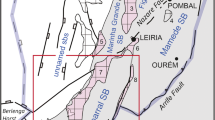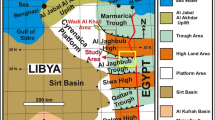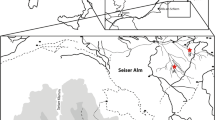Abstract
This paper documents the facies change in response to the Holocene transgression within five sediment cores taken in the lagoon of Mayotte, which contain a Type-1 depositional sequence (lowstand, transgressive and highstand deposits underlain by an erosive sequence boundary). Quantitative compositional analysis and visual examination of the bioclasts were used to document the facies changes. The distribution of the skeletal and non-skeletal grains in the lagoon of Mayotte is clearly controlled by (1) the rate and amplitude of the Holocene sea-level rise, (2) the pre-Holocene basement topography and (3) the growth-potential of the barrier reef during sea-level rise, and the changes in bathymetry and continuity during this period. The sequence boundary consists of the glacial karst surface. The change-over from the glacial lowstand is marked by the occurrence of mangrove deposits. Terrigenous and/or mixed terrigenous-carbonate muds to sandy muds with a mollusc or mollusc-ostracod assemblage dominate the transgressive deposits. Mixed carbonate-siliciclastic or carbonate sand to gravel with a mollusc-foraminifer or mollusc-coral-foraminifer assemblage characterize the early highstand deposits on the inner lagoonal plains. The early highstand deposits in the outer lagoonal plains consist of carbonate muds with a mollusc-foraminifer assemblage. Late highstand deposits consist of terrigenous muds in the nearshore bays, mixed terrigenous-carbonate sandy muds to sands with a mollusc-foraminifer assemblage on the inner lagoonal plains and mixed muds with a mollusc-foraminifer assemblage on the outer deep lagoonal plains. The present development stage of the individual lagoons comprises semi-enclosed to open lagoons with fair or good water exchange with the open ocean.










Similar content being viewed by others
References
Babinot JF, Kouyoumontzakis G (1995) Associations d’ostracodes d’un environment récifal envasé: le lagon de l’ile de Mayotte (Archipel des Comores, Océan Indien occidental). Geobios 18:17–38
Belperio AP, Searle DE (1988) Terrigenous and carbonate sedimentation in the Great Barrier Reef province. In: Doyle LJ, Roberts HH (eds) Carbonate-clastic transitions. Dev Sediment 42:143–174
Blomeier DPG, Reijmer JJG (1999) Drowning of a Lower Jurassic carbonate platform: Jbel Bou Dahar, High Atlas, Morocco. Facies 41:81–110
Cabioch G, Camoin GF, Montaggioni LF (1999) Postglacial growth history of a French Polynesian barrier reef tract, Tahiti, central Pacific. Sedimentology 46:985–1000
Camoin GF, Colonna M, Montaggioni LF, Casanova J, Faure G, Thomassin BA (1997) Holocene sea level changes and reef development in the southwestern Indian Ocean. Coral Reefs 16:247–259
Colonna M, Casanova J, Dullo WChr, Camoin G (1996) Sea-level changes and δ18O record for the past 34,000 years from Mayotte reef, Indian Ocean. Quat Res 46:335–339
Crevello PD (1991) High-frequency carbonate cycles and stacking patterns: Interplay of orbital forcing and subsidence on Lower Jurassic rift platforms, High Atlas, Morocco. In: Franseen EK, Watney WL, Kendall CGStC, Ross W (eds) Sedimentary modeling: computer simulations and methods for improved parameter definition, Vol 233. Kansas, Lawrence, pp 207–230
Davies PJ, Hopley D (1983) Growth facies and growth rates of Holocene reefs in the Great Barrier Reef. BMR J Aust Geol Geogr 8:237–252
Davies PJ, Symonds D, Feary DA, Pigram CJ (1989) The evolution of the carbonate platforms of northeast Australia. In: Crevello PD, Wilson JL, Sarg JF, Read JF (eds) Controls on carbonate platform and basin development, SEPM Spec Publ 44:233–258
Dodd JR, Siemers CT (1971) Effect of Late Pleistocene karst topography on Holocene sedimentation and biota, lower Florida Keys. Bull Geol Soc Am 82:211–218
Dullo WChr, Blomeier D, Camoin GF, Casanova J, Colonna M, Eisenhauer A, Faure G, Thomassin BA (1998) Sediments and sea Level changes of the foreslopes of Mayotte, Comoro Islands: direct observations from a submersible. In: Camoin G, Bergerson D (eds) Reefs and carbonate platforms of the Indian and Pacific Oceans. IAS Spec Publ 25, pp 219–236
Eisenhauer A, Wasserburg GJ, Chen JH, Bonani G, Collins LB, Zhu ZR, Wyrwoll KH (1993) Holocene sea-level determination relative to the Australian continent: U/Th (TIMS) and 14C (AMS) dating of coral cores from the Abrolhos Islands. Earth Planet Sci Lett 114:529–547
Elmoutaki S (1991) La dernière transition glaciaire–interglaciaire dans le canal de Mozambique: analyse palynologique d’une séquence sédimentaire du lagon de Mayotte (12°52′S—45°05′E). Mémoir D.E.A. Géoscience de l’Environment. Université d’Aix-Marseille III, Nancy, Paris VI, Paris VII et Toulouse III, Marseille, pp 1–45
Elmoutaki S, Lezine AM, Thomassin BA (1992) Mayotte (Mozambique channel). Vegetational and climatic evolution during the last glacial-interglacial transition and during the Holocene. CR Acad Sci 314 (Série III):237–244
Fairbanks R (1989) A 17,000-year glacio-eustatic sea level record: influence of glacial melting rates on the Younger Dryas event and deep-ocean circulation. Nature 342:637–642
Gardulski AF, Mullins HT, Oldfield B (1986) Carbonate mixed sediment cycles in ramp slope sediment: eastern Gulf of Mexico. Paleoceanography 4:555–565
Gischler E (2003) Holocene lagoonal development in the isolated carbonate platforms off Belize. Sediment Geol 159:113–132
Gout B, Guelorget O, Thomassin B (1989) Relation macrobenthos endogene/nature du substrat meuble, dans la province Indopacifique: cas des lagons de Mayotte (Comores) et de Nouvelle Caledonie (Ocean Pacifique Occidental). In: ISfR Studies (eds) Congés ISRS Biologie et Geologie des récifs coralliens quaternaires et tertiaires. Université d’Aix-Marseille II, Marseille, pp 67–68
Hallock P, Schlager W (1986) Nutrient excess and the demise of coral reefs and carbonate platforms. Palaios 1:389–398
Harris PT, Davies PJ, Marshall JF (1990) Late Quaternary sedimentation on the Great Barrier Reef continental shelf and slope east of Townsville, Australia. Mar Geol 94:55–77
Hillgärtner H (1999) The evolution of the French Jura platform during the Late Berriasian to Early Valanginian: controlling factors and timing. Geofocus 1, PhD Thesis Nr. 1240, Université de Fribourg (Suisse), Fribourg, Switzerland, 176 pp
Kouyoumontzakis G (1989) Bioclastes et foraminiferes du lagon nord est de l’ile de Mayotte: la radiale de Longoni. In: ISfR Studies (eds) Congés ISRS Biologie et Geologie des récifs coralliens quaternaires et tertiaires. Université d’Aix-Marseille II, Abstracts Volume, Marseille, pp 87–88
Kouyoumontzakis G, Arnoux A, Thomassin BA, Gout B (1991) Extension de la zone de sédimentation terrigène dans le lagon Nord-Est de Mayotte (Océan Indian occidental) sous l’effet de l’anthropisation récente. 3éme Congr. fr. Sédimentolo., Brest, 18–20. November 1991, Vol. Résumé, pp 181–182
Kuhn G (1984) Sedimentationsgeschichte der Bermuda North Lagoon im Holozän: Teil I, PhD. Thesis, Göttingen University, 126 pp
Larcombe P, Carter RM (1998) Sequence architecture during the Holocene transgression: an example from the Great Barrier Reef shelf, Australia. Sediment Geol 117:97–121
Maggiorani-Charpentier F, Maggiorani J-M (1989) About oysters of Mayotte island lagoon. In: ISfR Studies (eds) Congés ISRS Biologie et Geologie des récifs coralliens quaternaires et tertiaires. Université d’Aix-Marseille II, pp 99–100
Marshall JF, Davies PJ (1982) Internal structure and Holocene evolution of One Tree Reef, Southern Great Barrier Reef. Coral Reefs 1:21–28
Masse J-P, Thomassin BA, Acquaviva M (1989) Bioclastic sedimentary environments of coral reefs and lagoon around Mayotte Island (Comoro Archipelago, Mozambique Channel, SW Indian Ocean). J Coast Res 5:419–432
Newell ND, Imbrie J, Purdy EG, Thurber DL (1959) Organism communities and bottom facies, Great Bahama Bank. Bull Am Mus Nat Hist 117:181–228
Paulay G (1990) Late Cenozoic sea level fluctuations and diversity and species composition of insular shallow water marine faunas. In: Proceedings of the Fourth International Congress of Systematic and Evolutionary Biology, pp 184–193
Peerdeman FM, Davies PJ (1993) Sedimentological response of an outer-shelf, upper-slope sequence to rapid changes in Pleistocene eustatic sea level: Hole 820A, northeastern Australian margin. In: McKenzie JA, Davies PJ, Palmer-Julson A (eds) Proceedings of the Ocean Drilling Program, Scientific Results, Vol 133, pp 303–313
Scholl DW (1964) Recent sedimentary record in mangrove swamps and rise in sea level over the southern coast of Florida: Part 1. Mar Geol 1:344–366
Shinn EA, Hudson JH, Halley RB, Lidz B, Robbin DM, Macintyre IG (1982) Geology and sediment accumulation rates at Carrie Bow Cay, Belize. In: Rützler K, Macintyre IG (eds) The Atlantic barrier reef ecosystem at Carrie Bow Cay, Belize: I. Structure and communities, Belize Science Report 1. Smithsonian Contributions to Marine Science 12, p 63–75
Strasser A, Pittet B, Hillgärtner H, Pasquier J-B (1999) Depositional sequences in shallow-water carbonate-dominated sedimentary systems: concepts for a high-resolution analysis. Sediment Geol 128:201–221
Stuiver M, Reimer PJ, Bard E, Beck JW, Burr GS, Hughen KA, Kromer B, McCormac FG, v.d. Plicht J, Spurk M (1998) Calibration issues. Radiocarbon 40:1041–1083
Thomassin BA, Arnoux A, Coudray J, Froget C, Gout B, Kouyoumontzakis G, Masse JP, Reyre Y, Reys JP, Vacelet E (1989) La sédimentation actuelle dans le lagon de Mayotte (île volcanique à récif-barrière, SW océan Indien) et son évolution récente en liaison avec les apports terrigènes. Bull Soc géol France 6:1235–1251
Thomassin BA, Arnoux A, Elmoutaki S, Froget C, Kouyoumontzakis G, Lezine A-M (1991) La dernière transition glaciaire-interglaciaire dans le lagon de Mayotte (Canal de Mozambique, SW Océan Indien); première données sur la sédimentation Holocène et les paléoenvironment. 3éme Congr. fr. Sédimentolo., Brest, 18–20. November 1991, Vol. Résumé, pp 275–276
Zinke J (2000) Sedimentological evolution of the lagoon of Mayotte during the Holocene (Comoro archipelago, SW Indian Ocean). PhD Thesis, Kiel University, pp 1–204
Zinke J, Reijmer JJG, Dullo WChr, Thomassin BA (2000) Paleoenvironmental changes in the lagoon of Mayotte associated with the Holocene transgression. Proceedings of the International Conference of Past Global Changes, Prague, Czech Republic. GeoLines 11:150–153
Zinke J, Reijmer JJG, Thomassin BA (2001) Seismic architecture and sediment distribution within the Holocene barrier reef-lagoon complex of Mayotte (Comoro archipelago, SW Indian Ocean). Paleogeogr Paleoclimatol Paleoecol 175:343–368
Zinke J, Reijmer JJG, Thomassin BA, Dullo WChr, Grootes PM, Erlenkeuser H (2003a) Postglacial flooding history of Mayotte lagoon (Comoro Archipelago, southwest Indian Ocean). Mar Geol 194:181–196
Zinke J, Reijmer JJG, Thomassin BA (2003b) Systems tracts sedimentology in the lagoon of Mayotte associated with the Holocene transgression. Sediment Geol 160:57–79
Acknowledgements
The gravity cores from the Mayotte lagoon were obtained during the cruise CARLAMAY in 1989 by researchers from the Université d’Aix-Marseille and the Université de la Réunion of the French research programme CORDET 1989-90. We would like to thank G. Kouyoumontzakis, J. F. Babinot (University of Marseille) and Ph. Bouchet (Museum National d’Histoire Naturalle of Paris) for their help with the identification of the ostracods, foraminifera and gastropods. We thank the reviewers E. Gischler and D. Meischner for their constructive comments. We acknowledge A. Stahl and T. Bauch, P. Ferrieri and A. Remia for their help with the laboratory and photographic work. Financial support for this study was provided by grants of the Deutsche Forschungsgemeinschaft (DFG). This is IGM scientific contribution # 1335
Author information
Authors and Affiliations
Corresponding author
Annex 1: List of identified bivalves, gastropods and foraminiferans for selected levels within the core. Core number, depth in core, systems tract and calibrated calendar ages are indicated (Zinke et al. 2001, 2003b)
Rights and permissions
About this article
Cite this article
Zinke, J., Reijmer, J.J.G., Taviani, M. et al. Facies and faunal assemblage changes in response to the Holocene transgression in the Lagoon of Mayotte (Comoro Archipelago, SW Indian Ocean). Facies 50, 391–408 (2005). https://doi.org/10.1007/s10347-004-0040-7
Received:
Accepted:
Published:
Issue Date:
DOI: https://doi.org/10.1007/s10347-004-0040-7




